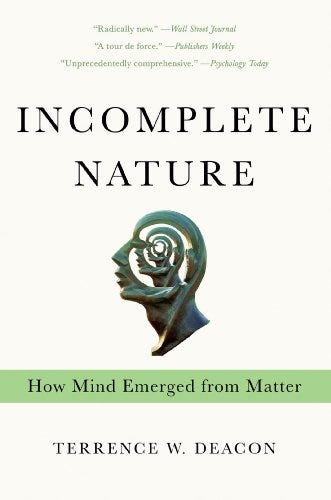5. Genetic Learning
Evolution as Meaning Generation
Of course, the universal learning process (and thus meaning) becomes appreciably clearer to recognize when, around 3.8 billion years ago, we see its first truly sublime product: Life—a particular kind of dissipative structure that can also reproduce itself via meaningful information. Such is the system–environment knowledge contained in the “genetic code.” Here, meaning truly comes into view, as the goal-directed character of biological behavior becomes overt and undeniable.
On this point, the work of neuroanthropologist Terence Deacon has been especially elucidating, offering a profound contribution to the reappraisal of meaning and teleology in the biological sciences. Since Darwin, teleology had been summarily eschewed from naturalistic descriptions of life and its development, replaced instead by an emphasis on blind meandering and undirected chance. Having identified the crucial efficient cause of natural selection (that is, the basic material cause-effect mechanism), biologists of the 19th and early 20th centuries believed they could then dispense with the idea of any teleological final cause such as Aristotle had once identified for organisms—which is to say, the idea that their end, goal, or purpose structurally in-forms them.
Ultimately, however, the failures of a purely reductionistic biology to adequately explain biological organisms without reference to goals and aims has led to a paradigm shift in the field, as emergentist frameworks from complexity science have helped shed important new light on long-vexing problems about biological behavior. Deacon’s work is a significant contribution to this paradigm shift. In his comprehensive 2012 book Incomplete Nature: How Mind Emerged from Matter, he offers a scientifically robust and philosophically compelling reconsideration of teleology’s role in biology.
By emphasizing the inherent lack or need of goal-directed entities (i.e., their “incompleteness”), Deacon removes teleology from a speculative metaphysical register and places it comfortably within a processual physical one. This allows us to see the commonalities that exist between all entities intrinsically constituted in processual relation to an absent goal state. As he puts it:
Such concepts as information, function, purpose, meaning, intention, significance, consciousness, and value are intrinsically defined by their fundamental incomplete-ness. They exist only in relation to something they are not.[i]
Such absence thus “motivates” (in the most basic etymological sense, we might say: “causes to move, animates”) the behavior of biological entities.
This dynamic is clearest in highly complex organisms like ourselves, who aspire, wish, will, intend, etc. Meaning and purpose are clear, we might say, within the PTB’s “person–society field” of Culture. But appreciating the deeper dynamic of motivational absence allows us to trace the quality of such meaning back down through less complex forms—which is precisely what we have been endeavoring to do here. As Deacon proposes:
Because it is complex, the concept of mental purpose can be progressively decomposed, revealing weaker forms of this consequence-organized relationship that do not assume intrinsic mentality. Thus the concepts of function, information, and value have counterparts in living processes, which do not entail psychological states, and from which these more developed forms likely derive.[ii]
To distinguish from the associations of purpose with more complex, cognitive versions of intentional behavior, Deacon coins the term “ententional,” which can apply also to unconscious goal-directedness at the purely biological level. Ententional entities are teleologically driven. As Deacon puts it explicitly: “Ententional processes and relationships can best be classed as expressions of final causality in Aristotle’s terms.”[iii]
In short, living organisms have meanings.
Keep reading with a 7-day free trial
Subscribe to Brendan Graham Dempsey to keep reading this post and get 7 days of free access to the full post archives.




